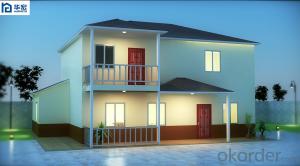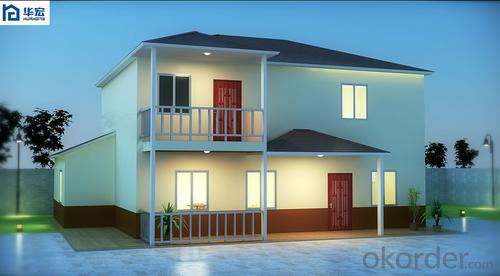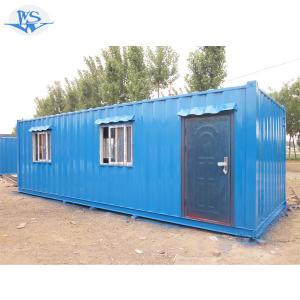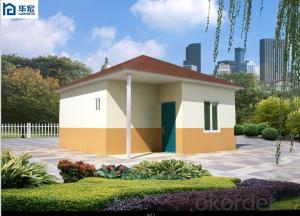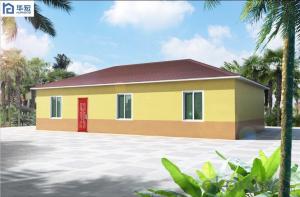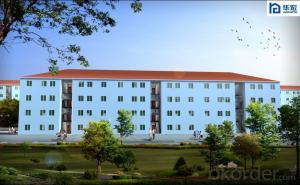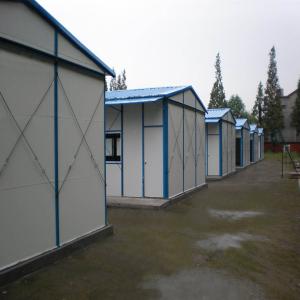Two floor cement house
- Loading Port:
- China Main Port
- Payment Terms:
- TT OR LC
- Min Order Qty:
- -
- Supply Capability:
- -
OKorder Service Pledge
OKorder Financial Service
You Might Also Like
More questions:
1, What's your Payment term:
30% deposit by TT, 70% balance before loading container by TT; 100% LC at sight(total payment over 100,000USD);
2, How about Shipping:
We use 20 feet container and 40HQ container to ship the goods; Usually one 20 feet container can load about 50-60 square meters' house, 40HQ container can load about 120-140 square meters's house.
3, How to become your agent in our country:
First, you can make a report about your market, include the the rules and laws of prefab house, popular house models, target price, and potential sales quantity.
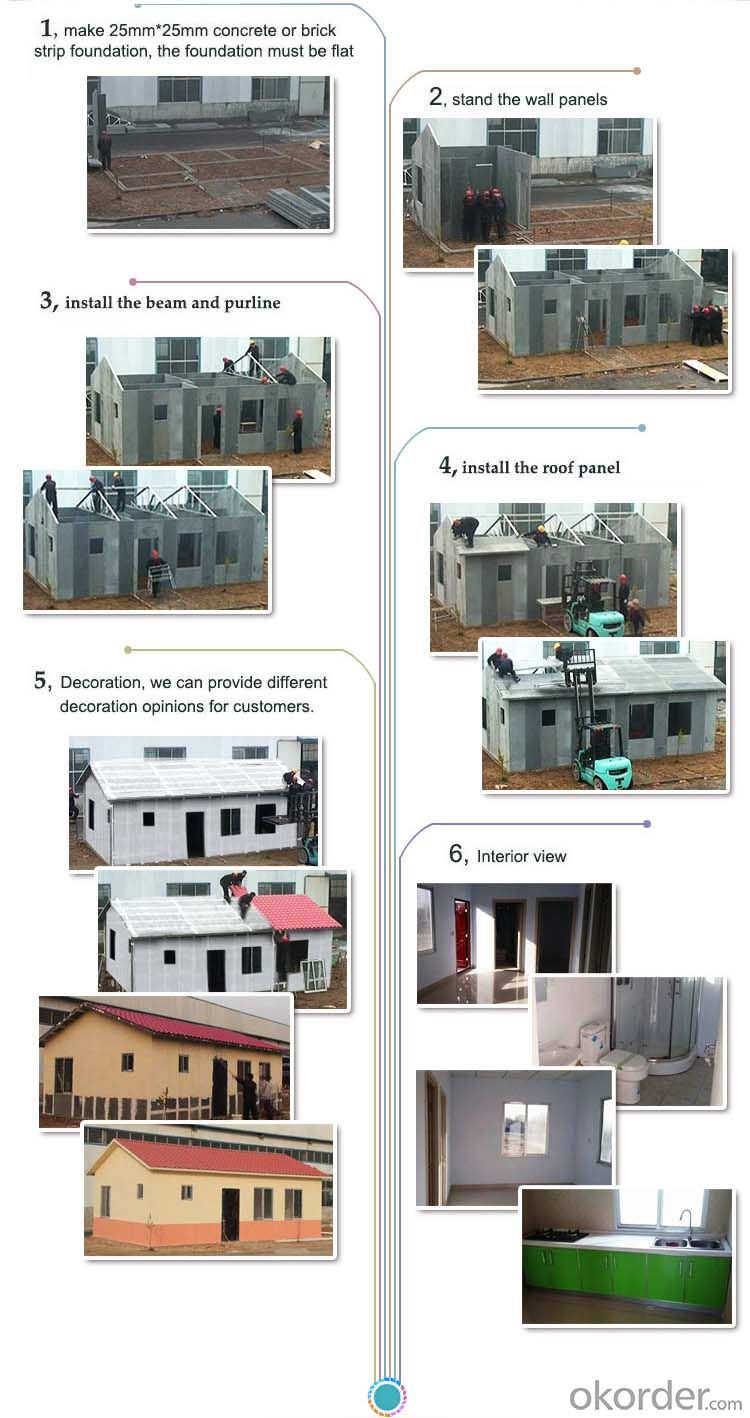
Second, you must place a trial order to act as the display.
Third, after finishing the sample house and getting the local people's feedback, we will give you the agent right in one area with limited time.
Fourth, Please note that we already have agent in Mumbai City India; Marshall Islands, Trinidad and Tobago.
4, Can you help me to purchase other things like furniture or appliance:
Because the customs law, our company can only export prefab house, so we just can purchase very little matched kitchen and bathroom facilities for you in consideration of customs clearance.
5, Can you send workers to help me build house.
Considering the labor cost, safety and visa issues, we suggest to send one or two engineers to guide and train your staffs. You must provide air tickets, hotel, and meal, and 100USD per day for engineer salary.
- Q: Can container houses be designed to have a spacious bathroom?
- Yes, container houses can be designed to have a spacious bathroom. While container homes typically have limited space, clever design and utilization of the available area can create a spacious bathroom. By incorporating innovative storage solutions, efficient layouts, and utilizing the vertical space, container houses can provide a comfortable and roomy bathroom experience.
- Q: Are container houses suitable for individuals who value privacy?
- Yes, container houses can be suitable for individuals who value privacy. With proper design and modifications, container houses can offer privacy through sound insulation, strategic window placement, and the use of landscaping or fencing to create a secluded environment. Additionally, container houses can be customized to include features like blinds or curtains for added privacy.
- Q: Do container houses require permits for construction?
- Permits are usually necessary for constructing container houses. The permits needed may differ based on local building codes and regulations. Container houses are often regarded as unconventional housing options in many areas, therefore specific regulations and requirements must be fulfilled to obtain the necessary permits. It is crucial to consult the local building department or planning commission to ascertain the specific permits and approvals needed for constructing container houses in your area. This will guarantee that your project complies with all relevant regulations, building codes, and zoning restrictions.
- Q: What is the characteristics of the office?
- because no one is willing to be called a Grade B office. In this way, can not wait for any one of the glass curtain wall, with elevator
- Q: Are container houses suitable for disaster relief efforts?
- Yes, container houses are suitable for disaster relief efforts. Container houses, which are made from repurposed shipping containers, have several advantages that make them a viable option for providing temporary housing in disaster-stricken areas. Firstly, container houses are readily available and can be quickly deployed to disaster zones. Shipping containers are abundant and can be easily transported by land, sea, or air. This allows for a rapid response to provide shelter for displaced individuals and families, minimizing the time spent without proper housing. Secondly, container houses are durable and weather-resistant. They are built to withstand harsh conditions during transportation, making them ideal for disaster-prone areas. These structures can withstand extreme weather events such as hurricanes, earthquakes, and floods, providing a secure and safe living environment for those affected by disasters. Additionally, container houses are cost-effective compared to traditional housing solutions. The use of repurposed shipping containers reduces construction costs, making it more affordable to provide housing for a larger number of people. Moreover, these structures can be easily modified and customized to meet the specific needs of disaster-affected communities. Furthermore, container houses are environmentally friendly. By repurposing shipping containers, we reduce waste and promote sustainability. These structures can be designed to be energy-efficient, incorporating renewable energy sources and eco-friendly materials, further minimizing their environmental impact. Lastly, container houses offer a sense of stability and privacy to those affected by disasters. They provide individuals and families with a personal space they can call their own during a challenging time. These structures can be designed to include basic amenities such as bathrooms, kitchens, and beds, ensuring that the basic needs of the occupants are met. In conclusion, container houses are a suitable option for disaster relief efforts. Their availability, durability, cost-effectiveness, environmental friendliness, and ability to provide a sense of stability make them an excellent choice for providing temporary housing in disaster-stricken areas.
- Q: What does the quadruple villa mean?
- Township villa with Shuangpin, four, six, and so on. Shuangpin is two suites share a gable, quadruple is four sets together
- Q: Can container houses be designed with a multi-unit complex?
- Indeed, it is possible to design container houses as a multi-unit complex. The versatility of container houses allows for easy stacking and arrangement in different configurations, enabling the creation of apartment buildings, dormitories, or small housing communities entirely composed of container houses. Container houses are constructed using shipping containers, typically 20 or 40 feet long. These containers can be stacked vertically or placed side by side to form multiple levels or adjacent units. By modifying and connecting the containers, larger living spaces, common areas, and shared facilities can be created. Furthermore, container houses can be customized to cater to the specific needs and preferences of the residents. They can be designed with various layouts, sizes, and amenities. For instance, a multi-unit complex can include units of different sizes, ranging from studios to larger family-sized containers. The containers can also be interconnected to establish shared spaces like kitchens, bathrooms, laundry facilities, or community areas. Container houses offer several advantages for multi-unit complexes. Compared to traditional construction methods, they are cost-effective as available containers can be repurposed for housing. Moreover, they are environmentally friendly, reducing waste by utilizing existing containers and promoting recycling. Additionally, container houses can incorporate sustainable features like insulation, solar panels, or rainwater harvesting systems, making them energy-efficient. To conclude, container houses can certainly be designed as a multi-unit complex. Their flexibility, affordability, and sustainability make them an appealing choice for creating distinctive and innovative housing solutions for various populations and needs.
- Q: Do container houses require maintenance?
- Yes, container houses do require maintenance. Like any other type of house, container houses need regular upkeep to ensure their longevity and functionality. This may include routine inspections, cleaning, repainting, and repairs to the structure, insulation, plumbing, and electrical systems. Maintaining a container house is essential to prevent any potential issues and to keep it in good condition over time.
- Q: What is the meaning of goods warehousing?
- The traditional definition of warehousing is given from the perspective of material reserves
- Q: Are container houses hurricane-resistant?
- Yes, container houses can be designed to be hurricane-resistant. The use of steel shipping containers provides a strong and durable structure that can withstand strong winds and storms. However, it is important to ensure proper engineering and reinforcement measures are taken during construction to enhance the hurricane resistance of the container house.
Send your message to us
Two floor cement house
- Loading Port:
- China Main Port
- Payment Terms:
- TT OR LC
- Min Order Qty:
- -
- Supply Capability:
- -
OKorder Service Pledge
OKorder Financial Service
Similar products
Hot products
Hot Searches
